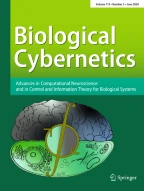Abstract.
The oculomotor integrator is a network that is composed of neurons in the medial vestibular nuclei and nuclei prepositus hypoglossi in the brainstem. Those neurons act approximately as fractional integrators of various orders, converting eye velocity commands into signals that are intermediate between velocity and position. The oculomotor integrator has been modeled as a network of linear neural elements, the time constants of which are lengthened by positive feedback through reciprocal inhibition. In this model, in which each neuron reciprocally inhibits its neighbors with the same Gaussian profile, all model neurons behave as identical, first-order, low-pass filters with dynamics that do not match the variable, approximately fractional-order dynamics of the neurons that compose the actual oculomotor integrator. Fractional-order integrators can be approximated by weighted sums of first-order, low-pass filters with diverse, broadly distributed time constants. Dynamic systems analysis reveals that the model integrator indeed has many broadly distributed time constants. However, only one time constant is expressed in the model due to the uniformity of its network connections. If the model network is made nonuniform by removing the reciprocal connections to and from a small number of neurons, then many more time constants are expressed. The dynamics of the neurons in the nonuniform network model are variable, approximately fractional-order, and resemble those of the neurons that compose the actual oculomotor integrator. Completely removing the connections to and from a neuron is equivalent to eliminating it, an operation done previously to demonstrate the robustness of the integrator network model. Ironically, the resulting nonuniform network model, previously supposed to represent a pathological integrator, may in fact represent a healthy integrator containing neurons with realistically variable, approximately fractional-order dynamics.
Similar content being viewed by others
Author information
Authors and Affiliations
Additional information
Received: 8 August 1997 / Accepted in revised form: 18 June 1998
Rights and permissions
About this article
Cite this article
Anastasio, T. Nonuniformity in the linear network model of the oculomotor integrator produces approximately fractional-order dynamics and more realistic neuron behavior. Biol Cybern 79, 377–391 (1998). https://doi.org/10.1007/s004220050487
Issue Date:
DOI: https://doi.org/10.1007/s004220050487
